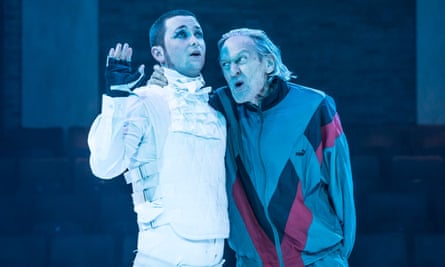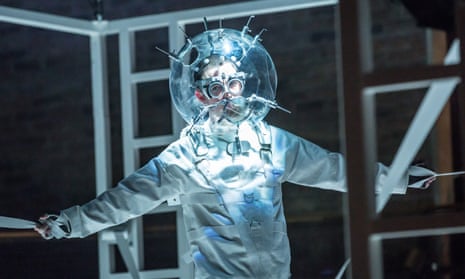A Clockwork Orange was the story Anthony Burgess couldn’t stay away from. Although reportedly written in a three-week burst and dismissed by its author as a “minor work”, the tale of ultraviolence and criminal correction kept tempting Burgess back to revise, adapt and comment on. In 1986 – more than two decades after the publication of the novel – he turned it into a play peppered with his own songs, now staged at the Liverpool Everyman.
It makes a sharp contrast with the first musical offering of the Everyman Rep Company’s 2018 season, Lerner and Loewe’s foot-tapping Paint Your Wagon. Here, the tunes are discordant rather than catchy. Burgess’s music – inspired by and interwoven with his protagonist Alex’s beloved Beethoven – is brilliantly uncanny, only misfiring when it briefly strays into sentimentality. From the first, teasing call of “What’s it going to be then, eh?” it transforms the novel into a chilling, nightmarish cabaret.
Troublingly, though perhaps aptly, Nick Bagnall’s production is never more stylish than when portraying Alex (a cold-eyed, sneering George Caple) and his droogs’ violent acts in the opening scenes. It takes a while to settle into the rhythms of this early, episodic section, which inducts us into teenager Alex’s world of random brutality. Spoken – or sung – on stage, Burgess’s invented Nadsat slang can be hard to catch, while Kay Haynes’s unsettling wash of ultraviolet light has a strange, distancing effect on the action. Afterwards, though, it is these striking, stripped-back moments that linger in the memory.

When Alex is dispatched to the institutional settings of prison and treatment centre, the style becomes increasingly cartoonish, lampooning the authority figures for whom he is little more than an experiment. The action takes its lead from Burgess’s twisted music-hall tunes, with macabre prison-yard dances and a Muppet-style puppet standing in for the jail’s manipulated governor. It’s only after the interval, as Alex is given his “freedom”, that the pace begins to become sluggish.
Without overreaching, Bagnall’s version finds plenty of contemporary resonances – never more so than when a “cured” Alex becomes a political plaything. The Minister of the Interior’s determination to cut crime rates at all costs feels worryingly plausible, as does the jockeying to use Alex as a vote-winning symbol. The one misjudged addition is a baffling and unnecessary visual reference to Jimmy Savile, which tips the scale from the intriguingly disturbing to the outright offensive.
No doubt Stanley Kubrick’s film version will loom large in the minds of many audience members, but the Everyman team work hard to create a distinct aesthetic. The spare white frame of Molly Lacey Davies and Jocelyn Meall’s set, with its frequently opening and closing trapdoors, swiftly and seamlessly takes us from city streets to prison to the lab where Alex is conditioned to be repulsed by images of violence. And the music – impressively performed by multi-instrumentalist Peter Mitchell – imposes a compelling layer of strangeness between the violence of Alex’s world and those of us watching it.
Perhaps Burgess’s greatest achievement with A Clockwork Orange remains its linguistic inventiveness, conveying the foreignness of adolescence with its own, unique lexicon. Despite some unevenness in the storytelling of the author’s adaptation, it is fascinating to experience that invented slang in song form, once again revitalising this much-adapted tale.
- At the Everyman, Liverpool, until 12 July. Box office: 0151-709 4776.

Comments (…)
Sign in or create your Guardian account to join the discussion